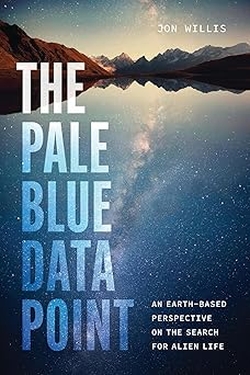Centauri Dreams
Imagining and Planning Interstellar Exploration
Biofinder: A Remote Sensing Solution for Detecting Life
My prediction that we’re going to find evidence for exo-life around another star before we find it in our own Solar System is being challenged from several directions. Alex Tolley recently looked at the Venus Life Finder mission, a low-cost and near-term way to examine the clouds of the nearest planet for evidence of biology (see Venus Life Finder: Scooping Big Science). Now we learn of advances in a ten-year old project at the University of Hawai’i at Manoa, where Anupam Misra and team have been working on remote sensing instruments to detect minute biomarkers. This one looks made to order for Mars, but it also by extension speaks to future rovers on a variety of worlds.
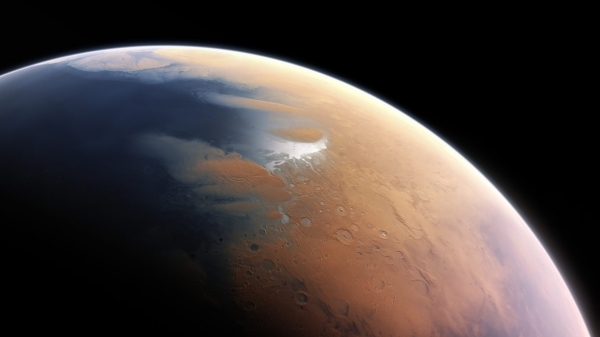
Image: This artist’s impression shows how Mars may have looked about four billion years ago. The young planet Mars would have had enough water to cover its entire surface in a liquid layer about 140 m deep, but it is more likely that the liquid would have pooled to form an ocean occupying almost half of Mars’s northern hemisphere, and in some regions reaching depths greater than 1.6 km. How can we best identify markers of early life, assuming they exist? Credit: NOVA Next / UH Manoa.
The challenge is immense, because the lifeforms in question may be tiny, and may have been extinct for millions, if not billions, of years. As Misra’s recent paper notes, organic chemicals formed by biology, or minerals produced by living organisms, are the kind of biomarkers research efforts have targeted. We’re talking about proteins, lipids and fossil residues, the detection of any of which on another planet would lock down the case for life off the Earth. Instruments that can sweep wide areas with sensors and deliver fast detection times are critical for invigorating the biomarker hunt.
Remote sensing is the operative term. Misra’s team have developed what they call a Compact Color Biofinder that, in the words of the paper, “detects trace quantities of organic matter in a large area at video speed.” Moreover, the device can operate from distances of a few centimeters up to five meters. The intent is to move quickly, scanning large areas to locate these biological tracers. The device draws on fluorescence, a short-lived signal that can be found in most biological materials, including amino acids, fossils, clays, sedimentary rocks, plants, microbes, bio-residues, proteins and lipids. According to the authors, fluorescence also figures into polycyclic aromatic hydrocarbon (PAHs) and abiotic organics, such as plastic or amino acids.
Misra, who is lead instrument developer at the Hawai’i Institute of Geophysics and Planetology at the university, makes the case that these traces are still viable, and that the Compact Color Biofinder can tell the difference between mineral phosphorescence and organic phosphorescence in daylight conditions with measurement times in the realm of one microsecond. It can also distinguish between different organic materials. Says Misra:
“There are some unknowns regarding how quickly bio-residues are replaced by minerals in the fossilization process. However, our findings confirm once more that biological residues can survive millions of years, and that using biofluorescence imaging effectively detects these trace residues in real time.”
Demonstrating the fact is news that the device can detect the bio-residue of fish fossils from the Green River formation, a geological feature resulting from sedimentation in a series of lakes along the Green River in Colorado, Wyoming and Utah. The formation is thought to be between 34 and 56 million years old. The fish in question is Knightia spp, which untangles to several different species within the genus Knightia (spp stands for species pluralis, meaning several different species within the larger genus). The now extinct fish lived in freshwater lakes during the Eocene. The team examined 35 fish fossils, all of which still retained a significant quantity of bio-fluorescence.
Detection is from a distance of several meters and can be achieved over large areas, which should greatly accelerate the process of astrobiological detection on a planetary surface. From the paper:
To further test the detection capability of the Biofinder the camera lens was changed to a long working distance microscope objective, thus turning the instrument into a standoff fluorescence microscope. The same fossil was cut into several pieces to be imaged in cross-section (Fig. 1c). At the microscopic scale, fluorescence images (Fig. 1d) demonstrated the clear presence of organic material in the fossil by the characteristic fluorescence of organic matter detected using a 10× objective at a working distance of 54 mm. The brown color material has been known to paleontologists to be organic matter formed from residues of fish bones along with soft tissues20 and hence, we can say that the organic fluorescence comes from biological origin.
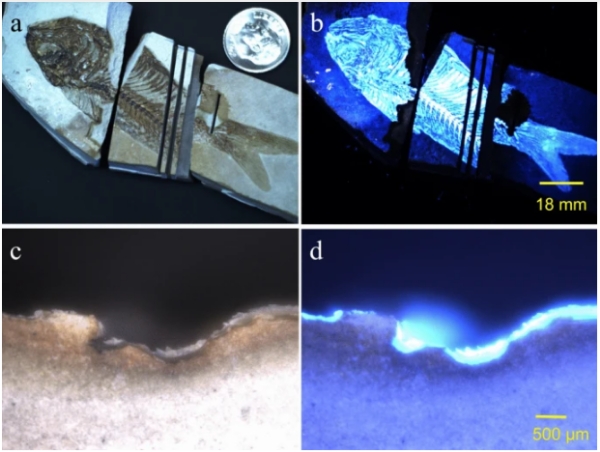
Image: This is Figure 1 from the paper. Caption: Biofinder detection of biological resides in fish fossil. (a) White light image of a Green River formation fish fossil, Knightia sp., from a distance of 50 cm using the Biofinder without laser excitation. (b) Fluorescence image of the fish fossil obtained by the Biofinder using a single laser pulse excitation, 1 µs detection time, and 3.6% gain on the CMOS detector. (c) Close-up white light image of the fish fossil cross-section using a 10× objective with 54 mm working distance showing the fish remains and rock matrix. (d) Fluorescence image with a single laser pulse excitation showing strong bio-fluorescence from the fish remains. Credit: Misra, et al., 2022.
So fluorescence imaging may join our toolkit for future rovers on other worlds, able to detect organisms that have been dead for millions of years by scanning large areas of terrain in short periods of time. The Biofinder detections were corroborated by a wide range of instruments, from laboratory spectroscopy analysis and scanning electron microscopy to fluorescence lifetime imaging microscopy.
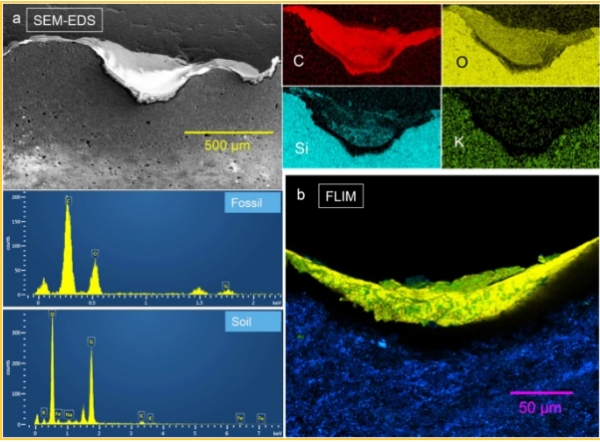
Image: This is Figure 3 from the paper. Caption: Confirmation of carbon and short-lived biofluorescence in fish fossil. (a) SEM-EDS analysis of the fish fossil cross-section showing that the fossil contains considerable quantities of carbon in comparison to the rock matrix. The rock matrix is rich in silica and has more oxygen than the fish. (b) FLIM image of the fossil cross-section showing strong bio-fluorescence in the fish (shown as false-coloured green-yellow region) with a lifetime of 2.7 ns. Credit: Misra et al.
The upshot: Biological residues can last for millions of years, and standoff bio-fluorescence imaging as used in the Compact Color Biofinder can detect them. Remote sensing is heating up in astrobiological circles, and I should mention two other ongoing projects: WALI (Wide Angle Laser Imaging enhancement to ExoMars PanCam) and OrganiCam, both based on fluorescence detection. The work of Misra and team indicates the method is sound, and should be capable of being deployed for large landscape surveys on future lander missions. The fact that the technology does not introduce contamination likewise speaks to its utility, says Sonia J. Rowley, a co-author of the paper and the biologist on the project:
“The Biofinder’s capabilities would be critical for NASA’s Planetary Protection program, for the accurate and non-invasive detection of contaminants such as microbes or extraterrestrial biohazards to or from planet Earth.”
The paper is Misra et al, “Biofinder detects biological remains in Green River fish fossils from Eocene epoch at video speed,” Scientific Reports 12, Article number: 10164 (2022). Full text.

Of Algorithms and Hidden Planets
It’s hard to imagine what the field of exoplanet discovery will look like in a hundred years. Just as difficult as it is to imagine what might happen if we do get to a ‘singularity’ in machine intelligence beyond which we humans can’t venture. Will the study of other stellar systems become largely a matter of computers analyzing data acquired by AI, with human operators standing by only in case of equipment failure? Or will the human eye for pattern and detail so evident in many current citizen science projects always be needed to help us piece together what the machines find?
I wonder this when I read about the effort going into teasing new data out of older observations, as we saw recently in VASCO, a project to study old astronomical photographic plates looking for possible technosignatures. And I suspect we’ll always need human/machine collaboration to draw maximum knowledge out of our data. Today let’s look at how useful software tools are illuminating what we’ve already learned about an exceedingly interesting and relatively close planetary system.
Sometimes it becomes necessary to begin writing about something by carefully explaining what it is not. In this case, I’m talking about the planetary system e Eridani, otherwise known as 82 Eridani, and it’s important to add that this is not the system known as Epsilon Eridani. The latter, interesting in its own right, is nearby (10.5 light years) and in fact is the third closest individual star system visible to the naked eye. The former, our subject today, is 20 light years out, a G-class dwarf with several confirmed planets. In the southern hemisphere Gould star catalogs, compiled in the late 19th Century, it is listed as the 82nd star in the constellation Eridanus.
This is potentially confusing enough that I’m going to use 82 Eridani rather than e Eridani in this article, which will look at an interesting way to study exoplanet systems that are close by, and one that offers useful new insights into what may be found in the 82 Eridani system that we have yet to discover. We already know about two planets, now confirmed, that were found through radial velocity data, and the same data suggest another. As many as six planets may exist here based on recent analysis by Fabo Feng (University of Hertfordshire) and colleagues in a 2017 paper.
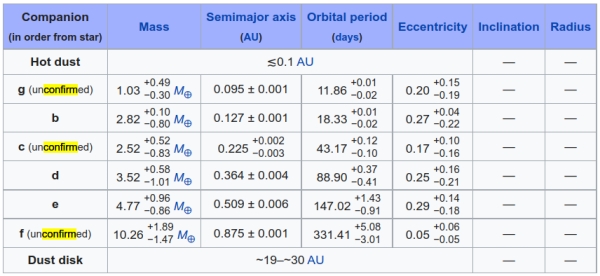
Image: This table shows what we currently know about the planetary system at 82 Eridani, including evidence for a dust disk. As we’re about to see, a hypothetical seventh planet turns up in the work we discuss below. Credit: Wikimedia Commons.
In a new paper in the Astronomical Journal, Ritvik Basant (University of Arizona) and colleagues go to work on the planetary architecture of 82 Eridani with a software package called DYNAMITE (developed by co-author Daniel Apai) that folds information specific to this system into a broader analysis incorporating what the authors call ‘exoplanet demographics.’ At stake here is this question: If an additional planet exists in a given system, what can we say about the probability distributions of its orbit, its eccentricity, its likely size? Let me quote from the paper:
To answer this question, DYNAMITE uses the robust trends identified in the Kepler exoplanet demographics data (orbital period distribution, planet-size distribution, etc., based on the ?2400 exoplanets that form the Kepler population) with specific data for a given single exoplanet system (detected planets and constraints on their orbits and sizes). Based on this information, DYNAMITE uses a Monte Carlo approach to map the likelihood of different planetary architectures, also considering the orbital dynamical stability and allowing for the freedom of statistical model choice.
I’m going into the weeds here because this package has already shown its worth. Back in 2020, Apai and co-author Jeremy Dietrich used DYNAMITE on 45 transiting systems discovered by TESS (Transiting Exoplanet Survey Satellite) to make predictions about undiscovered planets. Their work showed in multiple instances that an already discovered planet, if initially hidden from the software, would be retrieved by DYNAMITE, a test the software also passed when applied to the system at TOI-174, where more than one planet was removed and the probability of additional planets was noted in the software.
The accomplishments of DYNAMITE can be further examined in the paper, but I’ll mention its utility in the Tau Ceti system and its prediction of a habitable zone planet there, as well as interesting work on the K2-138 system, where it made what turns out to have been accurate predictions on two planets. So this seems to be a robust package, drawing heavily on existing data on planetary populations – it works best with the typical rather than the outlier, in other words, a fact to keep in mind before we extrapolate too freely.
Exoplanet science is all about tugging facts out of challenging data, as has been the case since the detection of 51 Pegasi b or, for that matter, the pulsar planets at PSR 1257+12. Continually refining our techniques through ever more sophisticated equipment sharpens radial velocity and transit detections, but we’re also learning how the right algorithms can be applied to the data we generate to suggest new targets for study. As our equipment improves, our algorithms are continually tuned up.
What we have so far for 82 Eridani shows the method at work in a system where our knowledge of several planet candidates is uncertain. DYNAMITE generates hypotheses exploring possible combinations of planet candidates. Each of these hypotheses produces predictions, and as it turns out, all four hypotheses produced for 82 Eridani result in planetary orbits that are quite similar. The authors also draw on a new DYNAMITE module that uses a statistical approach to explore possible surface temperatures. So this is a wide ranging look at the system, and they consider the work an “exploratory assessment” only, until more constraining data become available.
It will be interesting indeed to see how accurately this assessment describes what we will one day find with improved observational techniques. Beginning with the assumption of a system consisting of only the three known planets, DYNAMITE provides further support for the earlier work that predicted three more potential worlds (no information from the 2017 study, mentioned above, was used as input for the software). The parameters for the three candidate planets turn out to be in good agreement with the results of Fabo Feng and team. If all six planets, confirmed and unconfirmed, are used as input, DYNAMITE then predicts one additional planet in the habitable zone.
Here the software is suggestive in relation to the orbital eccentricity of these worlds:
From our eccentricity analysis, we find that if e Eridani is a three-planet system with planets b, d, and e, then the combined mean eccentricity for the system to be stable is ?0.05. If the system is a six-planet system instead, then the combined mean eccentricity for the system to be stable is of an order ?0.026. In either case, we find that the eccentricity of each planet should be significantly lower than the value fitted to the RV data, as also proposed by Feng et al. (2017a).
As the planetary system’s stability necessitates a lower-than-reported eccentricity for the planets, our analysis is based on this assumption. If better constraints on the eccentricities become available in future, then our analysis could be repeated again with the updated values.
So this is a rolling process, with the DYNAMITE results seeming to support seven planets at this star, including one additional candidate in the habitable zone, joining the previously predicted 82 Eridani f there. Indeed, the habitable zone around this star is wide enough, and the inner planetary system likely to be complex enough, to raise 82 Eridani higher on the list of planetary systems we will want to examine for life, using future direct imaging via space-based observatories and terrestrial extremely large telescopes. That new habitable zone planet candidate, by the way, would likely be a mini-Neptune rather than a terrestrial world based on the DYNAMITE results.
It’s interesting to see that Guillem Anglada-Escudé, the astronomer behind the discovery of Proxima Centauri b, worked with exoplanet hunter Paul Butler to develop an algorithm called TERRA to filter noise and sharpen radial velocity analysis. It was this algorithm that turned up the evidence for the three additional candidates at 82 Eridani in Feng and team’s 2017 paper that played into the work using DYNAMITE.
So we have three known planets at 82 Eridani, three more suggested by the TERRA analysis of the existing RV data and strengthened by the DYNAMITE results, and now a possible seventh world with an orbital period of 549-733 days in the habitable zone. Again, the new worlds here are planet candidates at this point and await further observation and analysis. The latter will give us one day the data that will tighten algorithms like these still further, giving us better options to distinguish between probabilities and decide which of them merit precious telescope time.
The paper is Basant et al, “An Integrative Analysis of the Rich Planetary System of the Nearby Star e Eridani: Ideal Targets for Exoplanet Imaging and Biosignature Searches,” Astronomical Journal Vol. 164, No. 1 (16 June 2022) 12 (full text). If you want to dig further into the background, the Feng et al. paper is “Evidence for at least three planet candidates orbiting HD?20794,” Astronomy & Astrophysics Vol. 605 (September 2017) A 103 (abstract).

White Dwarfs: Planetary System Rebirth?
Let’s catch up with white dwarfs, a kind of star that may spawn planetary systems of its own. For I’ve just found another case of archival data being put to good use in the form of a study of a white dwarf system called G238-44. Here, the data come from the Hubble instrument (specifically, its Cosmic Origins Spectrograph and Space Telescope Imaging Spectrograph), the Far Ultraviolet Spectroscopic Explorer (FUSE), and the Keck Observatory’s High Resolution Echelle Spectrometer (HIRES) in Hawaii.
What astronomers presented at a recent AAS conference is a picture of a system severely disrupted by its star’s transition to white dwarf status. Moreover, this is a star in the process of accretion with a distinct twist from earlier such discoveries. For the white dwarf – the remnant left behind after the system’s star went through its red giant phase – is actively drawing rocky and metallic material as well as ices from the debris of the disrupted system. These are the stuff of planet formation. We’re learning how extreme are conditions in what astronomers call an ‘evolved’ planetary system as it undergoes destruction and what may be a kind of rebirth.
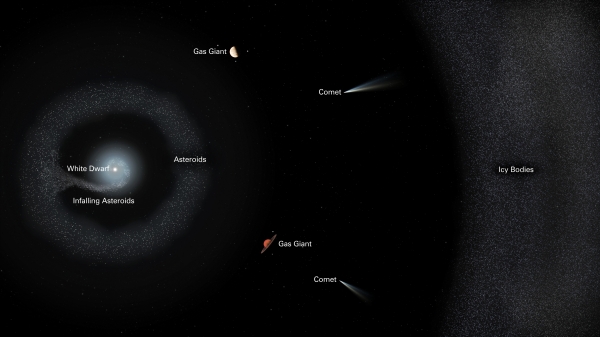
Image: This illustrated diagram of the planetary system G238-44 traces its destruction. The tiny white dwarf star is at the center of the action. A very faint accretion disk is made up of the pieces of shattered bodies falling onto the white dwarf. The remaining asteroids and planetary bodies make up a reservoir of material surrounding the star. Larger gas giant planets may still exist in the system. Much farther out is a belt of icy bodies such as comets, which also ultimately feed the dead star. Credit: NASA, ESA, Joseph Olmsted (STScI).
In relation to main sequence stars, white dwarfs give us new assumptions about planet formation. Such a star contains half the mass of the Sun, for example, but while it’s only a bit bigger than the Earth, it sports a density of 1 x 109 kg/m3. The average white dwarf is 200,000 times as dense as the Sun, a remnant stellar core with a temperature in the range of 100,000 Kelvin. And the system it finds itself in, surviving the red giant phase of the star, is hardly a static place.
To analyze what is happening at G238-44, we have to take into account that the original red giant, perhaps much like the Sun in its earlier days, would have cast off its outer layers as nuclear burning ceased. This shedding of mass can cause asteroids and small moons to be scattered gravitationally by remaining large planets, their own orbits disrupted. Materials like these experience tidal forces that can tear them apart as they move inward toward the star. The result: A disk of gas and dust that, over time, settles onto the surface of the white dwarf and throws a distinct observational signal.
At G238-44, the white dwarf left behind is seen in the process of accreting two such objects, a process observed before in a number of white dwarf systems but never with both icy and rocky-metallic components in the mix. Now we have a case of a white dwarf evidently drawing on a planetary system that was once abundant in ices. As UCLA’s Benjamin Zuckerman, a co-author of the paper on this work, notes:
“Life as we know it requires a rocky planet covered with a variety of elements like carbon, nitrogen, and oxygen. The abundances of the elements we see on this white dwarf appear to require both a rocky and a volatile-rich parent body – the first example we’ve found among studies of hundreds of white dwarfs.”
Within about 100 million years of the white dwarf’s formation, the star will be capturing material from regions analogous to our asteroid and Kuiper Belt. The total mass involved in this study is relatively small, about that of a large asteroid. Nitrogen, oxygen, magnesium, silicon and iron have been measured in the debris disk here, and in interesting proportions. Lead researcher Ted Johnson, a colleague of Zuckerman’s at UCLA, sees a 2-1 mix of Mercury-like material – high in iron and suggestive of a metallic planetary core – mixing with the comet-like debris.
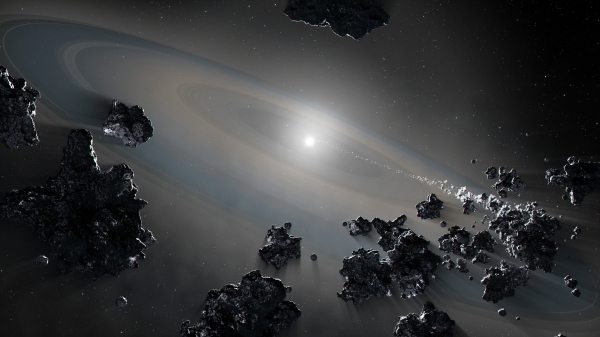
Image: This illustration shows a white dwarf star siphoning off debris from shattered objects in a planetary system. The Hubble Space Telescope detects the spectral signature of the vaporized debris that reveals a combination of rocky-metallic and icy material, the ingredients of planets. The findings help describe the violent nature of evolved planetary systems and the composition of its disintegrating bodies. Credit: NASA, ESA, Joseph Olmsted (STScI).
Terrestrial Planet in the Habitable Zone?
With this destruction derby in mind, let’s catch up with the white dwarf WD1054-226, found not so long ago to have objects – apparently of small moon or asteroid size – orbiting close to the star. Their presence is an indication, according to astronomers at University College London, that there may be a nearby planet in the star’s small habitable zone. This finding is based on data from the ESO’s 3.5m New Technology Telescope (NTT) at the La Silla Observatory in Chile. Fully 65 dips in the star’s light show the extent of the orbital material, whipping around the star in clouds every 25 hours.
A planet farther out seems the best explanation for how this arrangement stays in place, and if it is there, it would be in an orbit about 1.7 percent of the distance between the Earth and the Sun (roughly 2.5 million kilometers). That’s in the liquid water habitable zone, and the planet would be about the size of the Earth, based on these calculations.
What interesting scenarios stars like these represent. 95 percent of the stars in the galaxy will eventually become white dwarfs, with our Sun joining their ranks in four or five billion years. At WD1054-226, we’re hypothesizing the existence of a kind of planet that has yet to be confirmed around such a star. UCL’s Jay Farihi is lead author of the paper on this work:
“This is the first time astronomers have detected any kind of planetary body in the habitable zone of a white dwarf. The moon-sized structures we have observed are irregular and dusty (e.g. comet-like) rather than solid, spherical bodies. Their absolute regularity is a mystery we cannot currently explain. An exciting possibility is that these bodies are kept in such an evenly-spaced orbital pattern because of the gravitational influence of a nearby major planet. Without this influence, friction and collisions would cause the structures to disperse, losing the precise regularity that is observed. A precedent for this ‘shepherding’ is the way the gravitational pull of moons around Neptune and Saturn help to create stable ring structures orbiting these planets.”
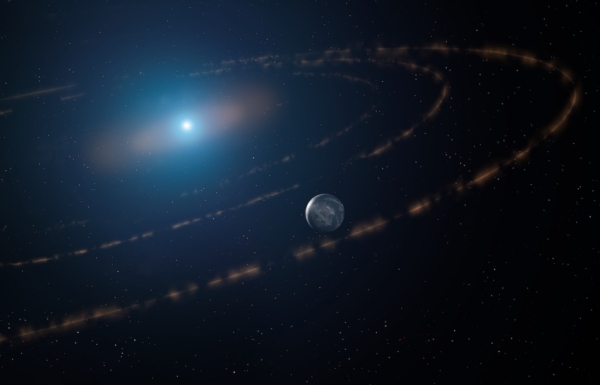
Image: An artist’s impression of the white dwarf star WD1054-226 orbited by clouds of planetary debris and a major planet in the habitable zone. Credit Mark A. Garlick / markgarlick.com. License type Attribution (CC BY 4.0).
Tantalizing, but remember that the ‘planet’ here is unconfirmed. JWST data on the debris disk would be helpful as we learn more. White dwarf planets of terrestrial size should eventually turn up if they’re out there in any numbers. If we could find a transit, we’d be looking at a world as large as the star it orbits. The transit depth that would afford if we can find a system so aligned would make for an unforgettable light curve.
The paper is Farihi et al., “Relentless and Complex Transits from a Planetesimal Debris,” Monthly Notices of the Royal Astronomical Society Vol. 511, No. 2 (April 2022), 1647-1666 (full text).

‘Lurker’ Probes & Disappearing Stars
We’ve looked before at the growing interest in exploring near-Earth space for evidence of probes from other civilizations that may have been sent in the distant past to monitor and report home on the progression of life in our Solar System. If extraterrestrial civilizations exist, the idea that one of them might have explored our system and left behind what Jim Benford calls a ‘lurker’ probe is sensible enough. We send probes to places we want to learn more about, and we would certainly have probes around the nearest stars if we had the means. Breakthrough Starshot is an example of such interest. A century from now, human probes to other stars may be commonplace.
Various places to search for lurker probes have been suggested, from Lagrange points – where objects placed there tend to stay put, with minimal need for fuel consumption – to barely studied Earth co-orbitals to the surface of the Moon. But what about Earth orbit? Surveillance of the Earth could involve probes in long-term high altitude orbits, the geosynchronous realm of our present-day communication satellites, which can always remain above the same location on the planet. As opposed to low-Earth orbits, GEO offers stable conditions over millions, perhaps billions of years.
The immediate objection is that looking into Earth’s sky is confounded by multiple factors. We have close to 5,000 satellites already in one kind of Earth orbit or another. We must also cope with centimeter-scale debris in lower orbits that seems to be increasing over time, another reason why higher orbits would be preferable for searching for something anomalous. Even so, human contamination near our planet means that using modern survey tools like Pan-STARRS is complicated and time-consuming.
If we had a time machine, we could see the sky as it was before Sputnik. But as Beatriz Villarroel and colleagues note in a new paper in Acta Astronautica, we have much easier ways of doing this. Photographic plate projects like the First Palomar Sky Survey (POSS-1) are available from earlier periods, and Villarroel (Stockholm University) is behind a new citizen science project called VASCO (Vanishing & Appearing Sources during a Century of Observations) to exploit these resources.
VASCO builds upon an earlier project of the same name in which Villarroel and colleagues analyzed old sky catalogs looking for stars that appear in the older plates but are not found in later imaging. In the earlier work, about 100 red transients turned up, interesting objects that likely represent flare stars worth follow-up investigation. The image below is drawn from this work (citation at the end of the article).
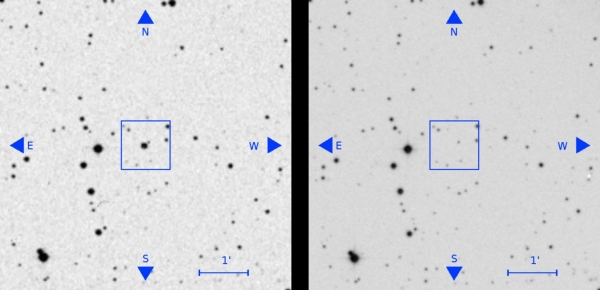
Image: A source visible in an old plate (left, seen as the bright source at the centre of the square) has disappeared in a later plate (right). Credit: Villarroel et al. (2019).
With the online VASCO project, the focus shifts to human volunteers, who work in the cause of finding anomalous features that may point to a technology in Earth orbit before the first Earth satellite flew. While VASCO uses the POSS-1 dataset, other plate material is available from the Lick and Sonneberg observatories and the Carte du Ciel, a decades-long mapping project from the early 20th Century. Interest in photographic plates is quickening because this is a resource ripe for analysis with our new digital tools. Thus projects like DASCH (Digital Access to a Sky Century @ Harvard), which has spent two decades thus far scanning photographic plates and archiving data.
Long-term Centauri Dreams readers will know that I champion the idea of using older datasets, which are priceless windows into the pre-digital sky. How we can exploit this material and expand our understanding with our new digital tools is an exciting area of research, and here we have the great benefit that the data have already been collected. We need build no new observatories to acquire information, but can concentrate on mining older plates for what may turn out to be new discoveries.
In the case of VASCO, the trick is to come up with the necessary filters to isolate anything that may be artificial, i.e., a technosignature. Low Earth orbits remain relatively uninteresting because they do not fit the long-term survival we’re presuming in a lurker, although fast-moving point sources in a long exposure can readily show natural objects like asteroids or meteors. An object in geosynchronous orbit may throw a glint when observer and reflective surface happen to be precisely aligned. But single glints are not enough. The authors are after indicators that cannot be confused with natural phenomena and are not the result of instrumental or photographic defects.
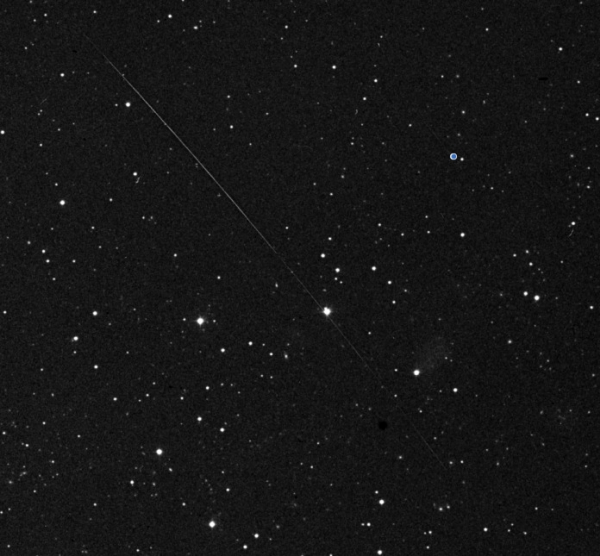
Image: This is Figure 2 from the paper. Caption: Fig. 2. A typical streak. The POSS-I streak found in a red image identified through the citizen science project shows the effect of tumbling and is a possible near-Earth asteroid but is also a possible candidate. The streak is roughly 40 arcminutes in length and unlikely to be a meteor with its angular velocity and pattern of first being dim, then brightens, and then dims once again. The typical exposure time for POSS-I images is about 50 minutes. Credit: Villarroel et al.
While a reflective satellite can produce a short, powerful glint, the glint shows a Point Source Function (PSF) shape that does not help us much. A point source is one that is smaller than maximum resolution of the equipment. An image of it seems to spread, a factor we must consider because of the diffraction of the telescope aperture. From the paper:
Satellites that are uniformly illuminated at low- or medium altitude orbits leave clear streaks in the long time exposures from old photographic plates as they move at speeds projected as hundreds of arcseconds per second. At higher or GEO altitudes the presence of satellites or space debris can be detected by fast, transient glints caused by surface reflection of the Sun. When the reflective surface of the satellite coincides perfectly with the position of the observer and the Sun, a short but powerful glint can be observed. Despite the fast movement of the satellite, the very brief reflective alignment means that the resulting short duration glint has a Point Source Function (PSF)-like shape…
And it turns out that a single glint on older photographic plates is indistinguishable from an astrophysical transient. In fact, ground-based searches for such transients today often pull up solar reflections from artificial objects in geosynchronous orbits. Moreover, 75 percent of glints from GEO, while not associated with any known object, are almost certainly centimeter-sized human space debris.
Going beyond the single glint, then, the paper analyzes multiple glints, and notes in particular glints with point source functions that occur along a straight line – which can occur when a spinning object reflects sunlight – and triple glints, another sign of possible rotation. And indeed, multiple glints have been found in at least one image exposed in 1950, though it is impossible to rule out contamination or emulsion defects on old photographic plates. What the authors are after is something more reliable:
The smoking-gun observation that settles the question unequivocally, is the one of repeating glints with clear PSFs along a straight line in a long-exposure image. When an object spins fast around itself and when its reflective surface faces the Earth, some of its parts could reflect sunlight. That results in multiple glints following a trail in an image. The number of glints might depend on the geometry and the speed of the rotation of the object. An object with only one single reflective surface that spins slowly will produce fewer glints than an object with several reflective surfaces that, moreover, spins fast. From the period one can also determine the shape of the glinting object.
This, then, is the kind of signature Villarroel and colleagues hope to find during the course of the VASCO investigations:
An exciting aspect of these suggestions is that precisely these type of objects could be found during the course of the VASCO project [8], [29]. Among the many objects classified as “Vanished”, we could discover both single and multiple glint objects. Also through automatised methods, we seek to identify all cases of multiple glints within a small area of 10 × 10 arcmin2, and to see if any of these represent cases where the glints follow a straight line.
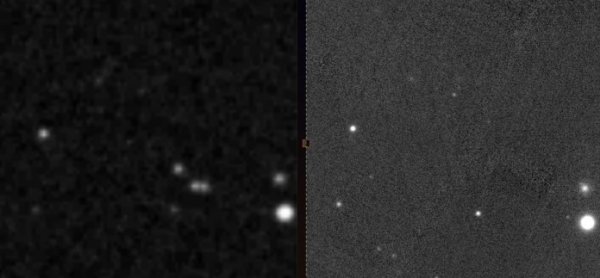
Image: This is Figure 5 from the paper. Caption: Fig. 5. Triple glints. An example of a triplet glints in a red POSS-I image from 1950s. The left column shows the POSS-I image, and the right column the Pan-STARRS image ( year 2015). The example is from Villarroel et al. (2021) [54] and uses the VASCO citizen science web interface. Credit: Villarroel et al.
A series of multiple glints along a line in photographic plate images, if found in the VASCO plates, would be of great interest, but there is a ticking clock, because trying to locate any such object today comes up against the growing volume of human-made space debris. The authors argue that searches for technosignatures in photographic plates should thus be done as soon as possible, and preferably performed on datasets beyond the POSS-1 material now used by VASCO.
A sky without human contamination in orbit is available through these plates, and if an object in geosynchronous orbit has been left behind – perhaps millions of years ago – as an observing platform or other kind of probe, this method is one way citizen science can be employed to spot it. Just how long a reflective surface can endure in an environment of dust grain and micrometeorite collisions is debatable, but of course we know nothing about what measures probe builders might take to protect their equipment. The authors think the imponderables keep VASCO a viable project.
The paper is Villarroel et al., “A glint in the eye: Photographic plate archive searches for non-terrestrial artefacts,” Acta Astronautica Vol. 194 (May 2022), 106-113 (full text). For earlier work, see Villarroel et al., “The Vanishing and Appearing Sources during a Century of Observations Project. I. USNO Objects Missing in Modern Sky Surveys and Follow-up Observations of a “Missing Star,” Astronomical Journal Vol. 159, No. 1 (2020) 8 (full text). Thanks to my friend Antonio Tavani for the pointer to the 2022 paper.

Comet Interceptor Could Snag an Interstellar Object

It pleases me to learn that Dutch astronomer Jan Oort was among the select group of people who have seen Halley’s Comet twice. At the age of 10, he saw it with his father on the shore at Noordwijk, Netherlands. In 1986, he saw it again from an aircraft. What a fine experience that would have been for a man who brought so much to the study of comets, including the idea that the Solar System is surrounded by a massive cloud of such objects in orbits far beyond those of the outer planets.
Image: Dutch astronomer Jan Oort, a pioneer in the study of radio astronomy and a major figure in mid-20th Century science. Credit: Wikimedia Commons CC BY-SA 3.0.
Halley’s Comet is a short-period object, roughly defined as a comet with an orbit of 200 years or less, and thus not a member of the Oort Cloud. But let’s linger on it for just a moment. The most famous person associated with two appearances of Halley’s Comet is Mark Twain, who was born in 1835 with the comet in the sky, and who sensed that its approach in 1910 would also mark his demise. As Twain put it:
I came in with Halley’s Comet… It is coming again … and I expect to go out with it… The Almighty has said, no doubt: ‘Now here are these two unaccountable freaks; they came in together, they must go out together.’
And so they did.
Edging in from the Oort
The Oort Cloud is an intriguing concept because by some accounts, it may extend halfway to the nearest star, meaning that it’s conceivable that the cometary cloud around the Sun nudges into a similar cloud around Centauri A/B, assuming there is one there. We use the Oort to explain the appearance of long-period comets, assuming that among these trillions of objects, a few are occasionally nudged out of their orbits and fall toward the Sun. The concept makes sense but observational data is sparse, as these dark objects are not directly observable until one of them moves inward.
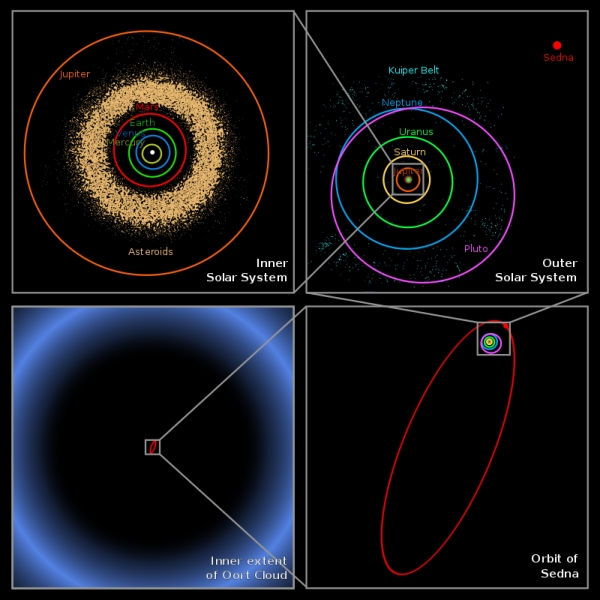
Image: The presumed distance of the Oort cloud compared to the rest of the Solar System. Credit: NASA / JPL-Caltech / R. Hurt.
We’ve recently learned about a long-period comet with interesting properties indeed. C/2014 UN271 (Bernardinelli-Bernstein) is the object in question, named after the two astronomers who discovered it in Dark Energy Survey (DES) data at a heliocentric distance of 29 au. Recent work with the Hubble Space Telescope has determined that the object may be as much as 130 kilometers across, making it the largest nucleus ever seen in a comet. Moreover, we can assume that it’s not an aberration.
David Jewitt (UCLA) is a co-author of the paper on this work:
This comet is the tip of the iceberg for many thousands of comets that are too faint to see in the more distant parts of the solar system. We’ve always suspected this comet had to be big because it is so bright at such a large distance. Now we confirm it is.”
Getting an accurate read on an object like this was no easy matter. At this distance from the Sun, the nucleus is too faint to be resolved even by the Hubble instrument, so Jewitt and team had to rely on data showing the spike of light where the nucleus was thought to be. Lead author Man-To Hui (Macau University of Science and Technology) led the development of a computer model of the surrounding coma, adjusting it to the Hubble data and then subtracting its glow, leaving behind the nucleus. Observations from the Atacama Large Millimeter/submillimeter Array (ALMA) confirmed its size and also made it clear that the nucleus is, as Jewitt puts it, “blacker than coal.”
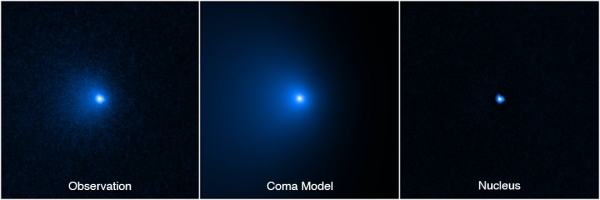
Image: Sequence showing how the nucleus of Comet C/2014 UN271 (Bernardinelli-Bernstein) was isolated from a vast shell of dust and gas surrounding the solid icy nucleus. Credit: NASA, ESA, Man-To Hui (Macau University of Science and Technology), David Jewitt (UCLA). Image processing: Alyssa Pagan (STScI).
Intercepting a Comet
If long period comets are difficult objects to study from Earth orbit, we may need to get up close with a spacecraft. It’s good to hear that the European Space Agency has approved the mission known as Comet Interceptor for construction, slotting it to fly in 2029 in the same launch that will carry the Ariel exoplanet finder into space. We’ve studied comets before, of course, including Halley’s, with notable success. But it’s obvious that short-period comets like the former and Rosetta target 67/P Churyumov-Gerasimenko would have been changed by their long proximity to the inner Solar System. What will we find when we study a newly arriving Oort object?
Michael Küppers is an ESA scientist working on the Comet Interceptor mission:
“A comet on its first orbit around the Sun would contain unprocessed material from the dawn of the Solar System. Studying such an object and sampling this material will help us understand not only more about comets, but also how the Solar System formed and evolved over time.”
Both Ariel and Comet Interceptor will proceed to the L2 Lagrangian point 1.5 million kilometers from the Earth, where the latter will wait for a target, presumably an Oort object jostled inward by gravitational interactions. Here we rely on the fact that comets are often detected more than a year before they reach perihelion, a time too short to allow for the construction of a dedicated space mission. The plan is to make Comet Interceptor ready to move when the time comes, performing a flyby of the incoming object and releasing twin probes to build up a 3D profile of the comet.
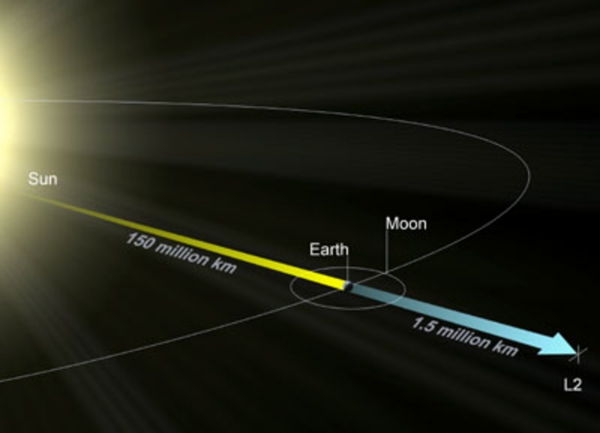
Image: An illustration of the L2 point showing the distance between the L2 and the Sun, compared to the distance between Earth and the Sun. Credit: ESA.
ESA will build the spacecraft and one of the two probes, the other being developed by the Japanese space agency JAXA. Given that over 100 comets are known to come close to Earth in their orbit around the Sun, along with the 29,000 asteroids cataloged so far, it will likewise be useful to have a better understanding of the composition of a pristine comet in case it ever becomes necessary to take action to avert an impact on Earth.
And if the target turns out to be an interstellar new arrival like ‘Oumuamua? So much the better. We should be finding more such newcomers shortly, given the success of the Pan-STARRS observatory and the development of the Large Synoptic Survey Telescope, now known as the Vera C. Rubin Observatory, under construction in Chile. Waiting in space for an Oort object or an interstellar comet means we won’t need to know the target in advance, but can adjust the mission as data become available. In any case, ESA is optimistic, saying Comet Interceptor “is expected to complete its mission within six years of launch.”
An ESA factsheet on Comet Interceptor can be found here. The paper on C/2014 UN271 (Bernardinelli-Bernstein) is Man-To Hui et al, “Hubble Space Telescope Detection of the Nucleus of Comet C/2014 UN271 (Bernardinelli-Bernstein),” Astrophysical Journal Letters Vol. 929, No. 1 (12 April 2022) L12 (abstract).

Europa: Catching Up with the Clipper
I get an eerie feeling when I look at spacecraft before they launch (not that I get many opportunities to do that, at least in person). But seeing the Spirit and Opportunity rovers on the ground at JPL just before their shipment to Florida was an experience that has stayed with me, as I pondered how something built by human hands would soon be exploring another world. I suppose the people who do these things at the Johns Hopkins Applied Physics Laboratory and the Jet Propulsion Laboratory itself get used to the feeling. For me, though, the old-fashioned ‘sense of wonder’ kicks in long and hard, as it did when Europa Clipper arrived recently at JPL.
Not that the spacecraft is by any means complete, but its main body has been delivered to the Pasadena site, where it will see final assembly and testing over a two-year period. Here I fall back on the specs to note that this is the largest NASA spacecraft ever designed for exploration of another planet. It’s about the size of an SUV when stowed for launch, but we know from the James Webb Space Telescope how large these things can become when fully deployed. In Europa Clipper’s case, the recently delivered main body is 3 meters tall and 1.5 meters wide. Extending the solar arrays and other deployable equipment takes it up to basketball court size.
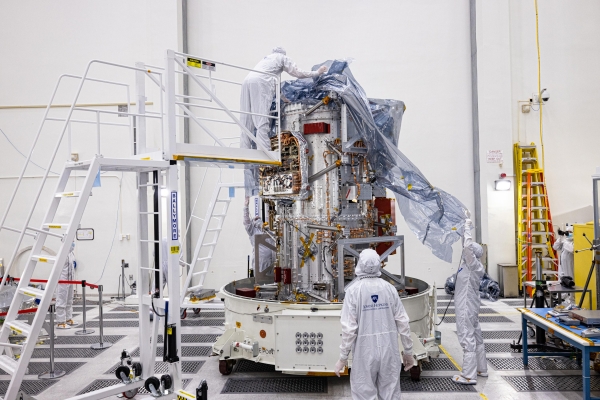
Image: The main body of NASA’s Europa Clipper spacecraft has been delivered to the agency’s Jet Propulsion Laboratory in Southern California, where, over the next two years, engineers and technicians will finish assembling the craft by hand before testing it to make sure it can withstand the journey to Jupiter’s icy moon Europa. Here it is being unwrapped in a main clean room at JPL, as engineers and technicians inspect it just after delivery in early June 2022. Credit: NASA.
Eight antennas are involved, powered by a radio frequency subsystem that will service a high-gain antenna measuring three meters wide, and as JPL notes in a recent update, the electrical wires and connectors collectively called the ‘harness’ themselves weigh 68 kilograms. Stretch all that wiring out and you get 640 meters, taking us twice around a football field. The main body will include a fuel tank and an oxidizer tank connecting to an array of 24 engines. Tim Larson is JPL deputy project manager for Europa Clipper:
“Our engines are dual purpose. We use them for big maneuvers, including when we approach Jupiter and need a large burn to be captured in Jupiter’s orbit. But they’re also designed for smaller maneuvers to manage the attitude of the spacecraft and to fine tune the precision flybys of Europa and other solar system bodies along the way.”
So what is arriving, or has arrived at JPL, is a spacecraft in pieces, its main body now joining key instruments like E-THEMIS, a thermal emission imaging system developed at Arizona State, and Europa-UVS, the mission’s ultraviolet spectrograph. E-THEMIS is an infrared camera that should give us insights into temperatures on the Jovian moon, and hence offer information about its geological activity. Given that we’re interested in finding places where liquid water is close to the surface, the data from this instrument should be extremely valuable during the spacecraft’s nearly fifty close passes.
The theory here is that as Europa’s surface cools after local sunset, the areas of the most solid ice will retain heat longer than areas with a looser, more granular texture. E-THEMIS will be able to map cooling rates across the surface. The infrared camera works in three heat-sensitive bands, and the warmer regions it should see may be the result of liquid water close to the surface, or possible impacts or convection activity. Not surprisingly, E-THEMIS lead project engineer Greg Mehall points to the radiation environment in Jupiter space as one of the team’s biggest issues:
“The extreme radiation environment at Europa gave far more design challenges for the ASU engineering team than on any previous instrument we’ve developed. We had to use dense shielding materials, such as copper-tungsten alloys, to provide the necessary protection from the expected radiation. And to ensure that E-THEMIS will survive during the mission, we also carried out radiation tests on the instrument’s electronic components and materials.”
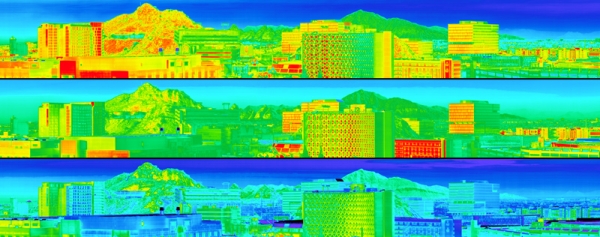
Image: The thermal imager will use infrared light to distinguish warmer regions on Europa’s surface, where liquid water may be near the surface or might have erupted onto the surface. The thermal imager will also characterize surface texture to help scientists understand the small-scale properties of Europa’s surface. In the image above, we’re seeing a diurnal temperature color image from the first light test of Europa Clipper’s thermal imager (called E-THEMIS), taken from the rooftop of the Interdisciplinary Science and Technology Building 4 on the Tempe Campus of Arizona State University (ASU). The top image was acquired at 12:40 PM, the middle at 4:40 PM, and the bottom image at 6:20 PM (after sunset). Temperatures are approximations during this testing phase. Credit: ASU.
As to the Europa-UVS instrument, this ultraviolet spectrograph will search for water vapor plumes and study the composition of both the surface and the tenuous atmosphere as it uses an optical grating to spread and analyze light, identifying basic molecules like hydrogen, oxygen, hydroxide and carbon dioxide.
The spacecraft’s visible light imaging system (EIS) is going to upgrade those well-studied images from the Galileo mission enormously. The plan is to map 90 percent of the moon’s surface at 100 meters per pixel, which is six times more of Europa’s surface than Galileo, and at five times better resolution. And when Europa Clipper swings close to Europa during a flyby, it will produce images with a resolution fully 100 times better than Galileo. The Europa Imaging System includes both wide- and narrow-angle cameras, each with an eight-megapixel sensor. Both of these cameras will produce stereoscopic images and include the needed filters to acquire color images.
All told, the spacecraft’s nine science instruments should be able to extract information about the depth and salinity of the ocean under the ice and, crucially, the thickness of the ice crust (I can imagine wagers on that issue going around in certain quarters). Gathering information about the moon’s surface and interior should further illuminate the issue of plumes from the ocean below that may break through the ice.
Assembly, test and launch is a two year phase that, by the end of this year, should see assembly of most of the flight hardware and the remaining science instruments. Kudos to JHU/APL, which has just delivered a flight system that is the largest ever built by engineers and technicians there. Now we look toward bolting on the radio frequency module, radiation monitors, power converters, the propulsion electronics and those hundreds of meters of wiring. Not to mention the electronics vault that must stand up to hard radiation.
The full instrument package will include an imaging spectrometer, ice-penetrating radar, a magnetometer, a plasma instrument, a mass spectrometer and a dust analyzer. Only two years and four months before launch onto a six-year journey of 2.9 billion kilometers. Europa Clipper isn’t a life-finder, but it does have the capability of detecting whether the moon’s ocean really does allow for the possibility of life to develop. It’s our first reconnaissance of Europa since the 1990s. What surprises will it reveal?
Bear in mind, too, that we still have ESA’s JUICE (JUpiter ICy moons Explorer) in the offing, with launch planned for 2023. I note with interest that on June 19, Europa will occult a distant star, which should be useful in tweaking our knowledge of the moon’s orbit before the arrival of both missions. Destined to end its life as a Ganymede orbiter, JUICE will make only two close passes of Europa, but its period of operations will coincide with part of Europa Clipper’s numerous flybys of the moon.

